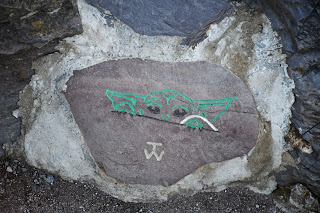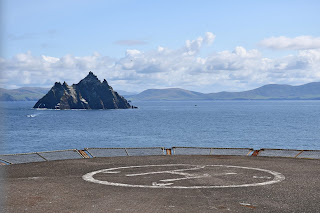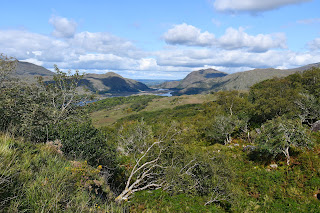Ireland: Day 5 – From the Skelligs to Cork
I could not sleep all night. Two days ago, I received an email saying that due to unpredictable weather conditions, it was unclear whether my boat ride to Skellig Michael would go ahead. The weather had been nice in the evening, but it seems so unpredictable in this corner of the world that this provided no guarantee. In my restless state on the verge of consciousness, I even dreamt that I had already driven to the marina and that I was waiting there for my ride.
After waking up once
more at around half past five, I decided to get ready and eat my breakfast, as
it was impossible to get back to sleep. To my relief, the dawn was bright and almost
cloudless. Indeed, once I had relocated to the centre of Portmagee, the boatmen
on the marina all agreed that today’s weather was the best they had seen in
weeks. Our boat left a little later than scheduled at around eight, but all
else turned out fine. The guide was an energetic and passionate man who kept
pointing out interesting sights while recounting the history of the area.
Very early on our
journey from Portmagee, we passed by Illaunloughan, a ruined island monastery
founded in the late seventh century. Likely connected to Skellig Michael, it is
much less visited due to its uninspiring proximity to the mainland and lack of
dramatic views. Farther out, our guide pointed out a tower, saying that these
structures dot the Irish coast and were built under English rule as lookouts
for French ships. He also showed us Valentia Island, where the first
Transatlantic cable was laid 150 years ago: after two very short-lived successes,
the third attempt proved to be the charm. It was the year 1866 and the cable transmitted
news of peace between Austria and Prussia – as well as a message from Queen
Victoria to President Andrew Johnson.
The first Skellig we
saw was Little Skellig. A barren island of towering grey rocks, its sides were
streaked white by the excrement of northern gannets; the island houses one of
the biggest colonies of these birds in the world. Interestingly, gannets do not
stay at Skellig Michael, which is much grassier and houses a giant population
of puffins. These arrive for a brief period in the summer to burrow and rear
their young, but we were told that the last of these departed some five weeks
ago to take up their residency on the open seas.
We landed on Skellig
Michael as part of the first wave of tourists to descend upon the island.
Following a brief safety presentation, we were released upon the six hundred
stairs that separate the sea surface from the monastery at the top of rock. In
the past, the monastery could be reached from three different landing points
depending on the prevailing winds, and the climb was very arduous: the earliest
monks probably only dug out a few footholds for themselves and the occasional
visitor. Nowadays, tourists use a single accessway, which was built by nineteenth
century lightkeepers who blew up the lowermost portion of the rock.
The hike was
exhausting but beautiful, and the sight at the end well worth it. At the top of
Skellig Michael stand the famous beehive-like huts constructed by the monks,
and on a day with good visibility, one can see Little Skellig tower above the
sea while the rolling hills of mainland Ireland add softness to the dramatic
scene. Next to the round buildings are the ruins of a church, which was
constructed at a later date, as can be ascertained from the use of mortar. The
graveyard by the old chapel is said to contain the relics of Saint Finnian, who
supposedly founded the settlement.
Many facts and stories
about the island were related to us by one of the island’s three custodians; if
I have understood correctly, there are five altogether, but they only ever come
in groups of three, as each custodian spends two weeks on the island and one
week on the mainland during tourist season. The custodian talked about the
daily life of the monks. They were almost entirely self-sufficient, keeping
their own vegetable gardens as well as some sheep and goats. They caught
rainwater to drink and had their own sewage system (though that feat is a
little less impressive considering they lived on a rock right above the sea).
To get to the island,
the monks had to row their boats for around seven hours – and so did their
guests. These visited the island for other reasons besides solitary meditation,
such as the purchase of indulgences and fleeing from authorities. They would
often bring gifts like tools and materials that were otherwise hard to come by.
This separated them from the Vikings, who pillaged the island several times.
There was nothing valuable on Skellig Michael itself, but the literate and
knowledgeable monks could be taken as high-end slaves.
Our visit lasted until
11:30, by which time we had clambered back down again and made ready to be
taken back to Portmagee. First, however, we were sailed around Skellig Michael
so that we could see some of the parts inaccessible to landing tours, namely the
structures associated with the nineteenth century lightkeepers. We also saw
several seals who seemed very nonplussed about making our acquaintance.
After eating a quick
lunch at Portmagee, I began my long drive to Cork. It was not exactly a direct
drive. Having done some ad hoc research the night before, I learned that there
were a few fortifications near Portmagee, namely Cahergall Fort and
Leacanabuaile Fort. Both were built in similar style to the monastery at
Skellig Michael: they were round and made of mortarless stone slabs. Cahergall
Fort was particularly impressive, its tall walls visible from a considerable
distance.
When I typed Cork into
my phone, the navigation wanted to send me along what I believed would be a
relatively boring path in the north. Instead, I traced my route towards
Killarney National Park, entering the area in the southwest and exiting it in
the northeast. Even before the park, the views did not disappoint. Driving up
and down mountain ridges and passes along a single-lane road, I often found
myself gazing at mountain peaks and over lakes. Sometimes, I had to slow down
for passing sheep, though most of the time I stopped it was to let other cars
pass me on the narrow strip of asphalt.
Although I
occasionally cursed my foolhardiness – especially when making way for a truck
with very little warning – the beauty and peacefulness of the whole area more
than made up for these minor inconveniences. I often found myself alone at the
lookouts, or at most in the company of a lone motorcyclist. And, while I
readied my camera, the clouds moulded the contours of the landscape below.
There were rocky hillsides as well as forests, deep blue lakes as well as
barren mountaintops. In the more farm-like areas, the surrounding shrubs
bloomed yellow, orange, and red, with fuchsias completely overtaking some of
the roadsides.









































Comments
Post a Comment